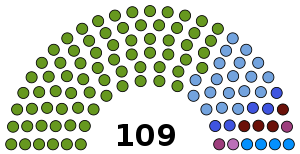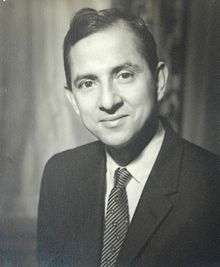1959 Nepalese legislative election
The Nepalese general election of 1959, held from 18 February to 3 April 1959, to elect the 109 members of the first House of Representatives, the lower house of the Parliament of Nepal.[6] It was conducted under the provisions of the Constitution of the Kingdom of Nepal, 1959, which was adopted on 12 February 1959.[7]
 | ||||||||||||||||||||||
| ||||||||||||||||||||||
All 109 seats in the Pratinidhi Sabha 55 seats were needed for a majority | ||||||||||||||||||||||
|---|---|---|---|---|---|---|---|---|---|---|---|---|---|---|---|---|---|---|---|---|---|---|
| Registered | 4,246,368[2] | |||||||||||||||||||||
| Turnout | 1,791,381 (42.18%) | |||||||||||||||||||||
| ||||||||||||||||||||||
 | ||||||||||||||||||||||
| ||||||||||||||||||||||
 |
|---|
| This article is part of a series on the politics and government of Nepal |
Executive:
Federal Parliament:
Judiciary: |
|
Administrative divisions
|
|
|
|
Related topics |
|
|
786 candidates competed for 109 seats in the Pratinidhi Sabha. More than 4.25 million people out of an overall population of about 8.55 million (1954) were eligible to vote.[8] Voter turnout was 42.18%.[5][2]
The result was a victory for the Nepali Congress, winning 74 of the 109 seats and 38% of the total votes polled.[9] B. P. Koirala became the first democratically elected and 22nd Prime Minister of Nepal.[10]
Political parties
A total of 9 parties and 268 independents contested for the 109 seats in the election. Nepali Congress contested in 108 constituency area and won in 74 places. The Gorkha Parishad, which had contested in 86 seats, had won a total of 19 seats, while the Nepal Communist Party, which had contested in 47 seats, was limited to only four seats.
Only 4 parties secured the position of National parties as per the then election act of Nepal 1959. The party presidents of eight of the nine parties lost the election. Nepali Congress Bishweshwar Prasad Koirala was the only party president who won the election from constituency No. 32 (Morang South Biratnagar West).[4]
Results
| Party | Votes | % | Seats |
|---|---|---|---|
| Nepali Congress | 666,898 | 37.2 | 74 |
| Nepal Rashtrabadi Gorkha Parishad | 305,118 | 17.1 | 19 |
| Samyukta Prajatantra Party | 177,408 | 9.9 | 5 |
| Nepal Communist Party | 129,142 | 7.2 | 4 |
| Prajatantrik Mahasabha | 59,896 | 3.3 | 0 |
| Nepal Praja Parishad (Mishra) | 59,820 | 3.3 | 1 |
| Nepal Praja Parishad (Acharya) | 53,038 | 2.2 | 2 |
| Tarai Congress | 36,107 | 2.1 | 0 |
| Nepali Rastriya Congress | 12,707 | 0.7 | 0 |
| Independents | 291,247 | 16.7 | 4 |
| Invalid/blank votes | – | – | |
| Total | 1,791,381 | 100 | 109 |
| Source: The Election Commission Report[5][2] | |||
Government formation
The speaker of the first Pratinidhi Sabha was Krishna Prasad Bhattarai from Nepali Congress.[11] The Pratinidhi Sabha started from 27 May 1959 and dissolved on 15 December 1960.
Facts
- Nepali Congress leader Subarna Shamsher Rana contested from three constituency and won all the three seats. He won from constituency No. 52 (Bara Parsa, Central North), constituency No. 53 (Bara, East Parsa) and constituency No. 91 (Gulmi, South-West).
- Nepal Congress leader Surya Prasad Upadhyaya contested from two constituencies, constituency No. 5 (Kathmandu Valley) and constituency No. 14 (Ramechhap, South) and defeated from both places.
- Gorkha Parishad president Randhir Subba was defeated from Constituency No. 26 Dhankuta. Tarai Congress president Vedananda Jha had lost from Constituency No. 39 Siraha. CPN (Maoist) General Secretary Keshar Jung Rayamajhi was defeated from Palpa Constituency No. 93. Democratic General Assembly president Ranganath Sharma was also defeated from Kathmandu Constituency No. 5. Dilliraman Regmi of the Nepali Rastriya Congress and Bhadrakali Mishra of Nepal Praja Parishad also lost the election.
- Tanka Prasad Acharya also lost the election from Kathmandu Constituency No. 5.[4][12]
References
- Joshi, Bhuwan Lal; Rose, Leo E. (1966). Democratic Innovations in Nepal: A Case Study of Political Acculturation. University of California Press.
- Devkota, Grishma Bahadur (1976). Nepalko Rajnitik Darpan II (in Nepali). Bhattarai Bandhu Prakashan. p. 111.
- "केवल एक पार्टी प्रमुखले जितेका थिए पहिलो आमनिर्वाचन" [Only one party leader won the first general election]. देशसञ्चार (in Nepali). 2017-12-01. Retrieved 2020-06-17.
- Kafle, Chandra. "४५ दिन लगाएर गरिएको २०१५ सालको चुनाव" [The election of 2015 BS was conducted in 45 days]. Setopati (in Nepali). Retrieved 2020-06-17.
- Parajulee, Ramjee P., 1955- (2000). The democratic transition in Nepal. Lanham: Rowman & Littlefield. p. 46. ISBN 0-8476-9577-8. OCLC 41951317.CS1 maint: multiple names: authors list (link)
- Dieter Nohlen, Florian Grotz & Christof Hartmann (2001) Elections in Asia: A data handbook, Volume I, p629 ISBN 0-19-924958-X
- Nohlen et al., p624
- Rama Devi Pant (1959-04-04). "First general election of Nepal 1959" (PDF). The economic weekly. Retrieved 2020-06-17.
- Nohlen et al., p654
- "Timeline" (PDF). constitutionnet.org. Retrieved 2020-06-17.
- "'चक्रव्यूह'मा सभामुख, किन हुन्छ काण्डैकाण्ड ?". Janata Samachar (in Nepali). Retrieved 2020-06-18.
- Nepal, Jagat. Pāhilo Sāmsād : BP-Mahendra Takraaw. Kaṭhamandu: Sangrila Books. ISBN 978-9937-9053-6-7. OCLC 944022824.
External links
- Rama Devi Pant: First General Elections in Nepal-I Recent Political Trends, - "The Economic Weekly", 21.Feb.1959, p.285-290
- Rama Devi Pant: First General Elections in Nepal-II, - "The Economic Weekly", 4.Apr.1959, p.483-485

